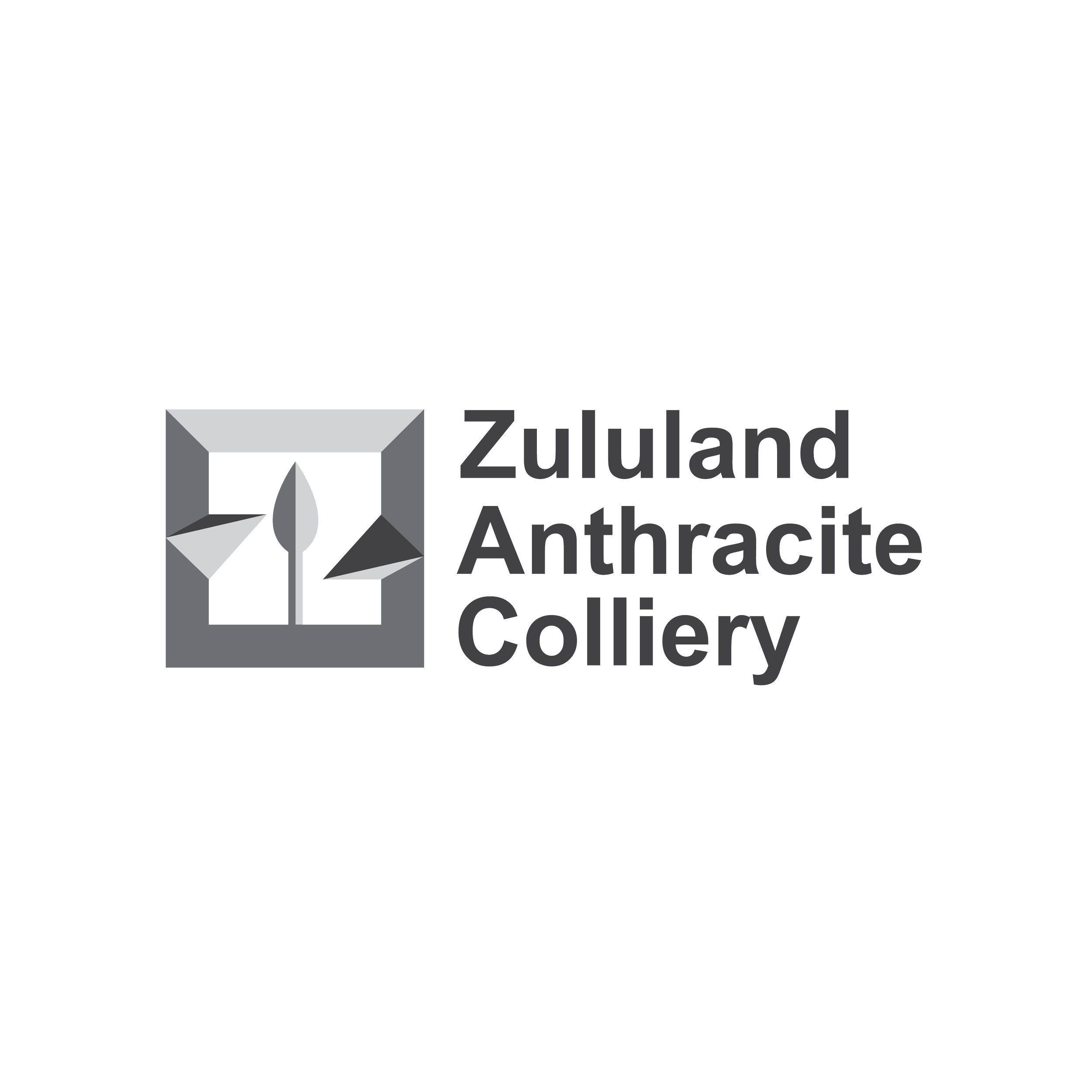ZAC’s reverse osmosis waste water treatment plant has the capacity to process 240 000 litres of water daily
Indawo yokuhlanza amanzi yaseZAC ikwazi ukuhlanza amalitha angu-240 000 amanzi ngosuku
Cutting-edge treatment plant provides clean water for the community
Clean, drinkable water is set to flow into the homes of an estimated 240 families near the Zululand Anthracite Colliery, following the launch of a Waste Water Reverse Osmosis Treatment Plant at the mine. Made possible through a partnership between ZAC and Dyad Group, the plant is designed to treat 240 000 litres of waste water from the mine’s operations every 24 hours. The R2.5 million project is aimed at enhancing ZAC’s water conservation efforts while benefitting surrounding households.
ZAC project manager Howard Atkinson says the mine embarked on the project to ramp up environmental efforts. “The commitment ZAC has made to conserve water and reduce its waste water volumes played a pivotal role in the decision to install the reverse osmosis plant,” says Howard.
This plant has the dual benefit of reducing the mine’s waste footprint and generating additional water supply for host communities. “We also realised that we were utilising our existing water treatment plant fully and there was not enough capacity to expand our freshwater output for local communities,” he adds.
Dyad Group’s project director, Samantha Chigwedere, explains that the average household uses about 1000 litres of water daily, meaning that 240 000 litres could reach an estimated 240 households. “We are taking waste water and purifying it so that it can be used for consumption, which is an amazing initiative,” says Samantha.
Waste water flowing from ZAC’s Outcrop, Deep E, and Ngwabe operations is captured into a reservoir, which is then treated through the reverse osmosis plant. Normally, such water would be recycled back into the mine’s coal processing cycle, however ZAC decided to take it a step further by treating it into drinkable qualities.
First, the water is pumped into an 84-cube raw water reservoir, then through a flocculant automatic dosing system. It then goes through the clarifier, where the solid substance is separated from the water. Upon separation, the solid matter sinks to the bottom, and the cleaner water overflows into reservoir tanks.
From the collection tanks, there is an array of filters and softeners, ensuring the removal of even tinier bits of dirt, odours, inorganic and organic matter. After filtration, the water is pumped to the reverse osmosis system, for purification before getting disinfected. "We use chlorine dioxide because of its longer residual effect, and it is the preferred method of disinfection according to the World Health Organisation," Samantha explains. The plant will be periodically maintained to ensure that it performs optimally, and a full-time plant operator will be appointed to conduct daily water tests.
The initiative will add to ZAC’s pipeline that has supplied water to the community over the years. As of April, this year, 31 470 000 litres were delivered to the community through the existing waterworks, while a total of 88 985 000 was provided in 2023.
Isikhungo sikanokusho sokuhlanza amanzi sihlinzeka umphakathi ngamanzi ahlanzekile
Kuzogeleza amanzi ahlanzekile naphuzekayo emakhaya emindeni ebalelwa kwengu-240 yangaseZululand Anthracite Colliery, ngemva kokwethulwa kweWaste Water Reverse Osmosis Treatment Plant emayini.
Le ndawo, eyenzeke ngokubambisana phakathi kweZAC neDyad Group, yenzelwe ukuhlanza amalitha angu-240 000 amanzi angcolile aqhamuka uma kusetshenzwa emayini nsuku zonke. Lo msebenzi owenziwe ngoR2.5 million uhlose ukwandisa umsebenzi wokuvikela imvelo weZAC futhi uhlomulise imizi engomakhelwane.
Imenenja yomsebenzi eZAC uHoward Atkinson ithi imayini iqale lo msebenzi ukwandisa umkhankaso wokonga imvelo. “Isibopho esenziwe iZAC sokonga amanzi nokunciphisa umthamo wamanzi angcolile sibeneqhaza elikhulu esinqumweni sokwenza indawo ehlanza amanzi angcolile ukuze aphinde asebenziseke,” kusho uHoward.
Le ndawo ishaya izinyoni ezimbili ngetshe elilodwa njengoba ukunciphisa amanzi angcolile akhiqizwa yinkampani kodwa futhi ikhiqizele umphakathi amanzi. “Sabona ukuthi indawo yethu ehlanza amanzi siyisebenzisa kahle nokuthi ayengekho kahle amandla okwandisa ukukhiqizela imiphakathi yendawo amanzi ahlanzekile,” kwengeza yena.
Umqondisi womsebenzi eDyad Group uSamantha Chigwedere uthi ikhaya elijwayelekile lisebenzisa amanzi alinganiselwa kumalitha ayinkulungwane nsuku zonke, okusho ukuthi angu-240 000 amalitha amanzi azofinyelela emizini engu-240. “Sithatha amanzi angcolile bese siwahlanza ukuze asetshenziswe, okungumkhankaso omangalisayo,” kusho uSamantha.
Amanzi angcolile asuka e-Outcrop, Deep E naseNgwabe eZAC agcinwa edamini, bese ehlanzwa ngokohlelo lokuhlanza amanzi asebenzile. Imvamisa amanzi anjalo abezosetshenziswa emsebenzi wokumba amalahle, kepha iZAC inqume ukuthi iwuqhube umsebenzi wokusebenzisa amanzi asebenzile ngokuthi iwahlanzele ukuthi aphuzeke.
Okokuqala, amanzi ampontshelwa edamini lamanzi angcolile angu-84 cube bese efakwa emshinini owenza ukuthi ukungcola kuzike emanzini. Emva kwalokho angena emshinini owahlanzayo, lapho khona izibhidi namanzi kuhlukana. Ema esehluzwa izibhidi zizika phansi bese amanzi ahlanzekile engena emathangini edamu.
Uma amanzi esephuma emathangini awaqoqayo, kunendathane yezisefo nezithambisi okuphinde kuqinisekise ukuphuma kwezibhidi zokungcola, amaphunga nezinto ezigayekayo nezingagayeki. Ngemva kokuhluzwa, amanzi ampompekela emshinini owadlulisayo ukuthi ahlanzwe ngaphambi kokukhishwa ubuthi. “Sisebenzisa i-chlorine dioxide ngenxa yamandla ayo okubulala ukungcola futhi iyindlela ethandwa kakhulu yi-World Health Organisation," kuchaza uSamantha.
Indawo yokuhlanza amanzi izovama ukubhekwa ukuqinisekisa ukuthi isesimweni esifanele nokuthi isebenza ngendlela. Kuzoqashwa umuntu ozoyibheka maduze ukuthi ahlole amanzi nsuku zonke.
Lo msebenzi uzokwengeza kowepayipi leZAC eselineminyaka lihlinzeka umphakathi ngamanzi. Kusuka ngoMbasa kulo nyaka, kuhanjiswe amalitha amanzi angu-31 470 000 emphakathini ngezindlela ezikhona zokuthutha amanzi, kanti angu-88 985 000 amalitha amanzi aselethiwe kusuka ngo-2023.

